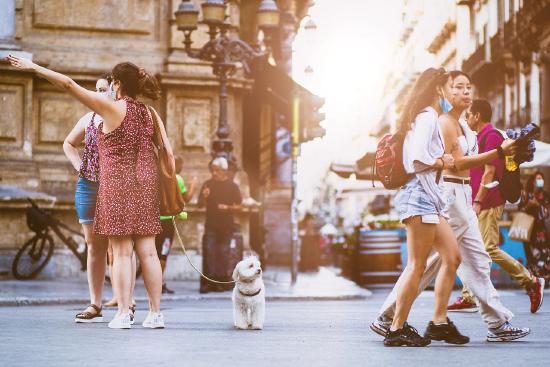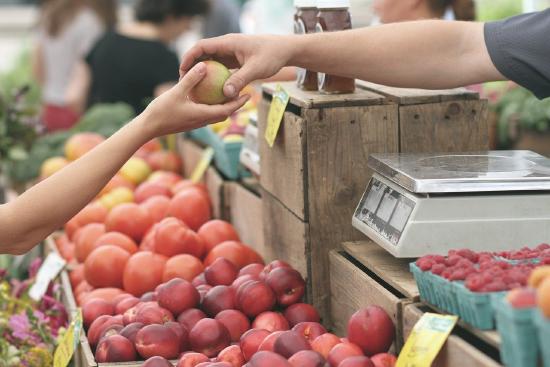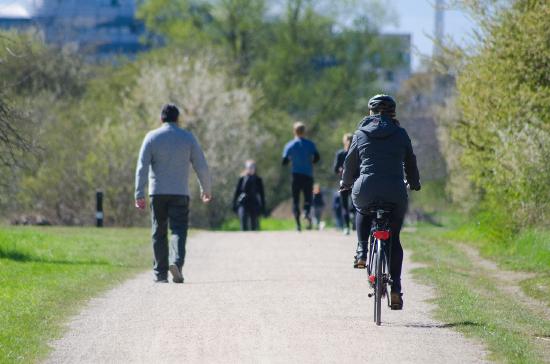5.2: Qu'est-ce qu'on fait en ville ?
( \newcommand{\kernel}{\mathrm{null}\,}\)
In this section, you will learn how to talk about what you're doing in town and where
Listen to the audio clips that follow on this page to hear the French pronunciation of vocabulary and examples presented.
On étudie !
 City Street
City Street
"People on street" by Sam Williams, Pixabay is in the Public Domain

"Apples" by Pexels, Pixabay is in the Public Domain
 "People in park" by Stan Petersen, Pixabay is in the Public Domain
"People in park" by Stan Petersen, Pixabay is in the Public Domain| Partitifs | Expressions de quantité |
|---|---|
| du, de la, des, de l' (some) | un peu de, assez de, beaucoup de, trop de, un tas de, pas mal de, etc. |
| de, d' ([not] any) | une tasse de, une boîte de, une feuille de, une bouteille de, une tranche de, un morceau de, un verre de, une part de, etc. |
Pour en savoir plus : Partitifs | Expressions de quantité
Qu'est-ce qu'on achète en ville ?
| Français | Anglais |
|---|---|
| timbre (m.) | stamp |
| dentifrice (m.) | toothpaste |
| médicaments (m.) | medicine |
| brosse à dents (f.) | toothbrush |
| journal (m.) | newspaper |
| goûter (m.) | snack |
| bouteille (f.) | bottle |
| boîte (f.) | box, can |
| cadeau (m.) | gift |
| marque (f.) | brand |
| biscuit (m.)* | cookie |
| gâteau (m.) | cake |
| pain (m.) | bread |
| coûter | to cost |
| demander* | to ask |
| vendre | to sell |
| faire des économies | to save money (spend less) |
| économiser | to save |
| cher, chère | expensive |
| coûteux, coûteuse | expensive, costly |
| bon marché | cheap |
| pas cher | not expensive |
*Faux ami
| Les mots apparentés | Les mots apparentés |
|---|---|
| carte postale (f.) | parfum (m.) |
| cigarette (f.) | prix (m.) |
| euro (m.) | sandwich (m.) |
| fleur (f.) |
Les passe-temps et les distractions
Qu'est-ce qu'on fait en ville ? Voici quelques activités que l'on peut faire en ville :
| Français | Anglais |
|---|---|
| assister à un spectacle | to go to a show |
| assister à un concert | to go to a concert |
| déposer de l'argent | to deposit money |
| retirer de l'argent | to withdraw money |
| emprunter un livre | to borrow a book |
| envoyer une lettre | to send a letter |
| faire les magasins | to go shopping |
| faire les vitrines | to window shop |
| manger avec des amis | to eat with friends |
| prendre des photos | to take pictures |
| prendre un café | to grab a coffee |
| oublier | to forget |
| voir un film | to see a film |
| voir une pièce de théâtre | to see a play |
| visiter une galerie d'art | visit an art gallery |
| retrouver des amis | meet up with some friends |
| s'amuser* | to have fun, to enjoy oneself |
| se balader* | to stroll around, take a walk |
| se débrouiller* | to manage, to get by |
| se déplacer* | to move |
| s'orienter* | to orient oneself, to get oriented |
*These verbs (starting with se and s') are reflexive verbs (verbes réfléchis). See 6.8 : Structure to learn how they are conjugated.
Study the Quizlet vocabulary flashcards. Listen and repeat the French pronunciation.
On pratique !
Activité A
Tu fais les courses. Complétez les phrase suivantes avec les articles partitifs (du, de la, de l', des), les articles indéfinis (un, une, des), ou de :
- D'abord, je vais à la papeterie pour acheter ________ stylos et ________ papier.
- Ensuite, je vais acheter ________ timbres à la poste.
- Au café, je vais prendre ________ café.
- Au supermarché, j'achète ________ sucre (sugar), ________ farine (flour) et ________ chocolat.
- A la pharmacie, je prends ________ aspirine et ________ savon.
- A la boulangerie, j’achète__________pain et________________croissants.
- A la poissonnerie, je vais prendre_________crevettes.
- A la crêperie, je vais prendre___________crêpe au chocolat.
Activité B
Choisissez la bonne expression de quantité.
- un morceau de, d’
- une tranche de, d’
- une bouteille de, d’
- un verre de, d’
- une tasse de, d’
- un kilo de, d’
- Je bois du thé dans ________ thé.
- Au supermarché, j’achète ________ tomates.
- Je voudrais ________ eau s’il vous plaît.
- Combien coûte ________ vin ?
- Il va prendre ________ de jambon cru.
- La souris prend ________ fromage.
Activité C
Qu'est-ce que tu prends ou tu ne prends pas comme boissons d’habitude ? Répondez en utilisant les articles partitifs appropriés (du, de la, de l', des) ou le négatif (de, d').
Vocabulaire utile :
| Français | Anglais |
|---|---|
| bière (f.) | beer |
| vin (m.) | wine |
| champagne (m.) | champagne |
| jus (m.) (de fruits) | (fruit) juice |
| lait (m.) | milk |
| eau minérale (f.) | mineral water |
| café (m.) | coffee |
| thé (m.) | tea |
| chocolat chaud (m.) | hot chocolate |
| petit déjeuner (m.) | breakfast |
| déjeuner (m.) | lunch |
| dîner (m.) | dinner |
| d'habitude | usually |
| ne...jamais | never |
| parfois | sometimes |
| commander | to order |
Modèle :
— Qu'est-ce que tu prends ou ne prends pas d'habitude avec le petit déjeuner ?
— D'habitude, je prends du jus d'orange mais je ne prends pas de café.
- — Que prends-tu quand tu ne peux pas dormir ?
— Je prends ________.
- — Qu'est-ce que tu prends quand tu as besoin d'étudier ?
— Je prends ________.
- — Qu'est-ce que tu aimes commander quand tu sors avec tes copains ?
— J'aime commander ________.
- — Que prends-tu quand tu as mal à la tête ?
— Je prends ________.
- — Qu'est-ce que tu ne prends pas le matin ?
— Je ne prends pas ________.
- — Qu'est-ce que tu ne prends jamais ?
— Je ne prends jamais ________.
- — Qu'est-ce que tu préfères boire au café ?
— Je préfère boire ________.
Activité D
Qu'est-ce qu'on peut faire dans les endroits suivants ? Pour chaque endroit, sélectionnez une activité appropriée.
Modèle : Au centre commercial, on peut faire des achats.
| Endroit | Activité |
|---|---|
| 1. à la boulangerie | a. goûter du Merlot |
| 2. à la librairie | b. acheter du dentifrice |
| 3. à l'épicerie | c. acheter des fruits |
| 4. à la papeterie | d. acheter du papier |
| 5. au salon de beauté | e. prendre un café |
| 6. à la boutique des vins | f. boire du thé |
| 7. à la laverie | g. laver les vêtements |
| 8. à la pharmacie | h. acheter des livres |
| 9. au café | i. acheter du pain |
| 10. au salon de thé | j. acheter des éclairs |
| 11. au marché de dimanche | k. acheter des cartes postales |
| 12. à la boutique de souvenirs | l. acheter du fromage |
Activité E
Les endroits et les activités. Cherchez les endroits où on fait les activités suivantes.
Modèle : On y fait du ski ➔ On fait du ski à la montagne.
- Nous y dînons avec nos amis. ➔ ________.
- On y fait la fête. ➔ ________.
- Nous y pique-niquons parfois. ➔ ________.
- Nous y étudions. ➔ ________.
- On y regarde la télévision. ➔ ________.
- On y fait de l’exercice. ➔ ________.
Activité F
Dans quel établissement est-ce qu'on peut trouver ces articles ?
- Let's look at how these two people in the video complete this activity.
- To practice, you can listen and repeat their dialogues. Then ask similar questions from your classmate.
| Français | Anglais |
|---|---|
| préposition (à, dans, chez...) + lieu = Y | preposition (to, at, in...) + place = there |
Pour en savoir plus.
Modèle : du jus d'orange (orange juice) ➔
Étudiant(e) 1 : On peut y trouver du jus d’orange. Où est-ce ?
Étudiant(e) 2 : On peut trouver du jus d'orange dans une épicerie.
- un roman
- un journal
- du dentifrice et des brosses à dents
- du papier
- des médicaments
- des stylos et un classeur
- une bière
- un sandwich
Activité G
Faisons des achats en ligne. Allez sur les sites suivants :
Note: If you are unable to open the link here, please search the name of the store online.
Find the following items on the sites above. Then write down the price and brand (if it applies) of each item.
- Une paire de chaussures blanches.
- Un paquet de chips.
- Le livre L’étranger de Camus.
- Une petite table en bois.
- 3 cahiers
- Un stylo rouge, un stylo noir et un stylo bleu.
- Une trottinette électrique
- Un ordinateur (PC) portable
- Un sac à dos
On approfondit !
Use the following resources to type accents and/or search for words:
- Accents: ç, à, é, è, â, ê, î, ô, û, ù, ë, ï, ü
- Dictionnaire français-anglais


